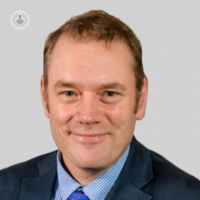How to treat a rotator cuff tear
Written in association with:The rotator cuff is a group of muscles and tendons that surround your shoulder joint, if it tears it can cause pain, weakness and sometimes a crackling sensation when you move your shoulder in certain positions.

We spoke to leading orthopaedic surgeon, Mr Phil Wright, to find out more details about the signs of rotator cuff tears, what can be done to treat this injury and what the average recovery time is.
What are the warning signs of a rotator cuff tear?
The first sign of a rotator cuff tear is usually gradually worsening pain, most commonly felt over the side of the shoulder (deltoid), particularly when lifting the arm to the side (abduction). In some cases, pain can come on suddenly after an injury to the shoulder. Pain may be associated with loss of movement and/or strength. Less often weakness develops without the onset of pain. Many people develop rotator cuff tears without symptoms, in fact this type of tear is twice as common as painful tears. In a 2019 study of asymptomatic American college baseball players in their late teens and early twenties 47% had partial rotator cuff tears on an ultrasound scan.
What can cause a rotator cuff tear?
Although the word “tear” implies an injury, most rotator cuff tears occur over time as part of the normal ageing process. In some people this happens at a younger age than others and the reasons for this are poorly understood. It has been suggested that there may be a genetic component responsible. It may be that the tendon ages more quickly in people who use their shoulders to carry out heavy manual activities as part of their occupation. Traumatic tears, where the tendon is suddenly ripped from the bone, are much less common and require a great deal of force. Where these occur patients should be seen by a shoulder surgeon without delay.
Can tears heal on their own? What can happen if left untreated?
Many scientific studies have repeated scans of patients with rotator cuff tears over time. It has never been shown that they spontaneously heal. Scientific studies have looked at repeated MRI scans of untreated rotator cuff tears and over a two-year period 82% of full tears increased in size compared with only 26% of partial tears.
What medical treatments and lifestyle habits can help recovery?
For people with painful rotator cuff tears pain relieving tablets are often helpful. Exercise to maintain the mobility of the shoulder and strengthen muscles can improve symptoms. The advice of an experienced physiotherapist is invaluable in deciding which exercises are most likely to help and ensuring they are being done correctly. Where pain makes it difficult to perform physiotherapy, a pain-relieving injection can be useful to overcome this although some clinicians feel that steroid injections may further weaken tendon tissue. In patients who continue to experience pain despite these measures, surgery may be considered.
What is the average recovery time?
There are many factors that can affect the rate of recovery from rotator cuff repair surgery and taking as many as possible into consideration maximises the potential for a speedy and complete recovery. In a large scientific study looking at 273 patients with rotator cuff tears, at 8 months 77% recovered whilst at 24 months this figure had risen to 85%.
Patients who were fit and active before surgery tend to recover more quickly as they have better muscle tone and flexibility which gives them a head start in their recovery. In many cases physiotherapy prior to surgery (pre-habilitation) can also accelerate postoperative rehabilitation by maximising movement and strength. Physiotherapy continues to be of paramount importance after surgery has taken place. Rotator cuff repair requires a period of 4 weeks in a sling to protect the shoulder whilst healing begins to take place.
This inevitably leads to a degree of stiffness and muscle weakness which takes time to resolve. Patients engaged in a non-manual occupation may return to work from 6 weeks and manual workers from 3 months. Where there is any doubt advice should be sought from the surgeon or physiotherapist. As a general rule, driving should only be attempted when the driver is confident they are in control of the vehicle to the same degree as they were before surgery. As a general guide, driving should not be attempted until around two weeks after the sling has been discarded. It is often wise to try short journeys on quieter roads before attempting longer trips. Most patients who undergo surgery successfully resume sporting or leisure activities. There is a wide variety in sporting activity and levels of participation and it is wise to make individual plans in consultation with both the treating surgeon and physiotherapist.
In order to treat a rotator cuff tear, it is recommended you chat with a leading orthopaedic surgeon such as Mr Phil Wright. Visit his Top Doctors profile today for more information.


